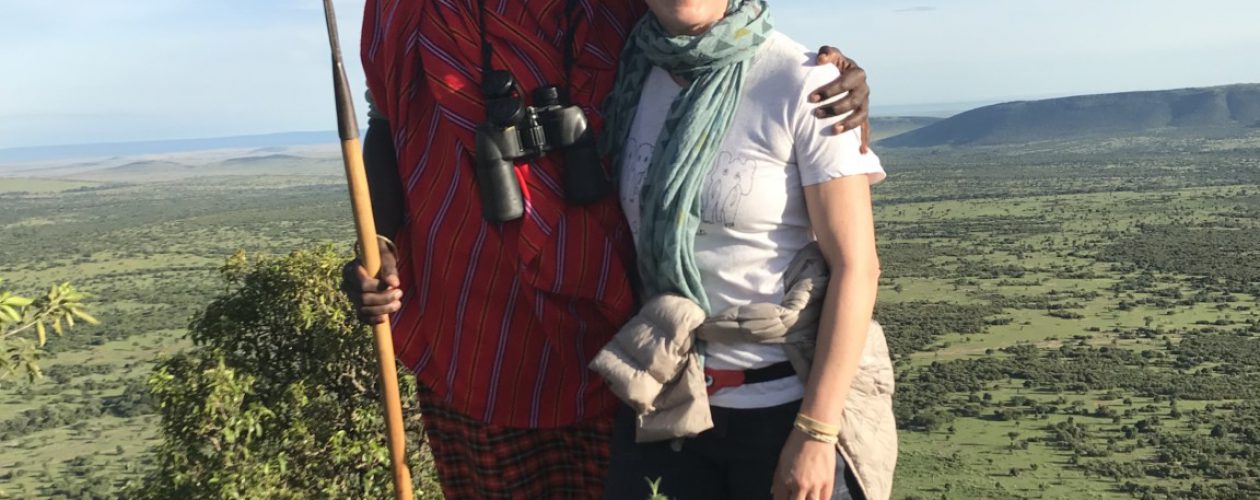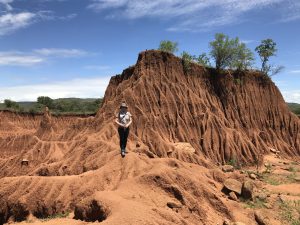Victoria just returned from a fantastic trip to Kenya. She shares her safari experiences with us in her own words …
Being in Kenya during the long rains is like visiting for the first time. Everyone is delighted to see you, chats about the weather and how the wildlife is enjoying the new green shoots and shrubs. There is something very magical about Africa in the green season (including a lot of babies) and I went prepared for muddy days but was pleased to enjoy many sunny days and only a few muddy adventures. It was the perfect opportunity to experience some fabulous properties, each with unique features during a very quiet time of year.
Our first stop was Ol Jogi, a luxury, private property available for exclusive use, located in the Laikipia region of Northern Kenya. The focus of the property is wildlife conservation, in particular that of the black rhino and during the course of our stay, we learned about the plight of these beautiful creatures and the program developed by the conservation team, headed up by its manager, Jamie Gaymer.
The flight to Ol Jogi is a pleasant 45 minute journey, and took us over tea and coffee plantations, Solio and Ol Pejeta and past the staggering sight of Mount Kenya. On arrival it was a quick 10 minutes from the airstrip to the property, during which time we were treated to a preview of the local game – dik dik, impala, gerenuk (perhaps my new favorite antelope) as well as species only seen in Northern Kenya, the reticulated giraffe, Baisa oryx and the Grevy’s zebra.
Arriving at the house was a pleasant assault on the senses. Set on the edge of a kopje, the gardens are filled with beautiful flowers – almost tropical. We were welcomed by Fred and the team with refreshments as we entered the home, and first and foremost this is a home. Lavishly decorated with art and artifacts collected by the family, the home is very welcoming. Most of the social activities take place on the outdoor living area with its marvelous views of the watering hole, the bush and Mount Kenya beyond that. The waterhole is a hive of activity, day and night, as a procession of game comes and goes, though our highlight was definitely 3 male lions wandering by one evening during after dinner drinks (yes, we did leap into a vehicle to track them). Other wonderful features of the property include the hide, where the animals are as close as you can be and, for after a hot day, the pool, spa and gym area.
In addition to the incredible opportunities to participate in conservation efforts, daily activities included game drives (where we enjoyed time with elephant, black and white rhino and even tracked a leopard on its failed attempt to snag dinner), bush walks, hiking through some incredibly diverse scenery – a highlight was their own “Grand Canyon” trail, and meeting some of the rescued residents, including a very charming young lady, Mei Mei, a 2 year old black rhino, whose sight was saved through medical intervention. Experienced riders can also enjoy a riding excursion.
Our varied activities were interspersed with lovely sundowner spots and some magical dining experiences, with meals beautifully created by Sylvain, the delightful French chef who has been with the family for years, using many ingredients from his own garden.
Cottars 1920’s Camp
We said goodbye to Ol Jogi and Mount Kenya (which was on full display as we left). Our next stop took us south over the Aberdares and the Rift Valley to Kenya’s most famous wildlife destination, the Maasai Mara, home to some of the densest wildlife in Africa. Due to the recent rains, we were unable to land at Cottars own airstrip, so instead landed at Keekerok, one of the Mara’s main “hubs” (loosely used term but there is a restroom at the airstrip). This meant a longer transfer though it was essentially a game drive the entire way, so we did enjoy seeing herds of impala, some ellies and baboons on the way to camp. The vehicles were outfitted with blankets, waterproofed on one side, with which we could cover ourselves as we traversed the wet landscape.
Cottars is located to the east of the National Park in its own concession. The 9 tents, including 4 family tents are spacious and spaced nicely apart, each with their own small open area. The décor is classic, old world safari, with family photos from the last 99 years adorning the walls, and antique furnishings accessorizing the rooms. Our room featured an old gramophone! At the same time, all the modern comforts were available. Each room is assigned a butler, who kindly woke us up in the early hours with a warm cuppa and it was lovely to enjoy a hot water bottle every evening, tucked into our beds during the turndown service. Make sure to let your butler know if you want the window flaps of your tent left open – it was fabulous listening to the sounds of Africa at night and there was plenty of activity going on, as the broken branches attested to each morning.
The camp faces south, towards the Serengeti and at the heart lies the mess tent, with a welcoming lounge area, bar and dining – though we enjoyed a variety of dining location experiences. The staff are delightful and attentive and the food was excellent, featuring menus that incorporated the produce from their own gardens. In addition to twice daily game drives, where we enjoyed the sights of elephants, cheetah, giraffe, antelope and more, activities included hiking, e-biking (whizzing through the bush brought back happy childhood memories) and cultural visits to the local school and village.
Once again, I won’t spoil the surprises but the camp offered us a couple of charming opportunities to step back in time and experience some timeless safari luxury – think bubbles!
Campi Ya Kanzi
And then we were off again, this time to our final camp, Campi Ya Kanzi, located in the Chyulu Hills between Amboseli National Park at Tsavo West. The Chyulus are best remembered in literature as Ernest Hemingway’s Green Hills of Africa. Our flight took us back over the Rift Valley as well as Lake Natron and its pink flamingoes and white pelicans before arriving at the camp’s own airstrip, where we were welcomed by camp owners, Luca, Antonella and their 2 young sons.
The camp is clearly focused on eco-tourism and the tents, more modest in size but featuring all modern amenities, showcase nature in the earth tones of the linen, the beautiful photography and the bath products, which are provided in recyclable glass bottles. The camp is situated to make the most of its spectacular views toward Mount Kilimanjaro, the world’s tallest, freestanding mountain. During our welcome by Luca, we learn all about the camp’s very successful conservation model and how they are working with the local communities to minimize human wildlife conflict and improve educational opportunities for the next generation.
Most of the meals are served family style at a beautiful table in the heart of the lodge but, for those special meals, the lodge will surprise guests with more romantic dining locations.
The Chyulu (meaning “devil” in Swahili) hills are volcanic in nature and as a result offer year round water sources to local wildlife, which includes elephant, buffalo, predators and plenty of antelope and giraffe. The grassland vegetation gives way to the “cloud” forest, very lush and tropical in nature, and fantastic for guided hikes. In addition to hiking and nature walks, we enjoyed games drives (including a chance to pass by some serious lava flows) and a visit to the local school, as well as the Maasai Wilderness Trust headquarters.
I don’t want to give too much away but our final evening included the most unique dining experience I’ve had on safari to date.
The above routing was an excellent example on how to incorporate three stunning and diverse ecologies into your Kenyan safari. While the three lodges I stayed at definitely excel at what they do with regards to wildlife conservation and local communities, there are several other camps in Kenya that also follow similar practices. At African Portfolio we always ensure that the camps we book, put wildlife and local communities first, while offering an amazing safari for guests at the same time!

